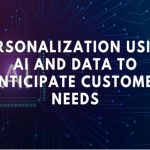 To optimize energy consumption, conducting a comprehensive analysis of energy data and taking action based on the insights gained is crucial. This approach can reduce energy waste and promote sustainability. As the energy industry grows, they require more advanced statistical methods to study how much energy to use and what helpful information to provide. Because of this, the business has had to develop and start using more advanced techniques to keep up with the changes. State-of-the-art applications and advanced techniques such as Machine Learning and Artificial Intelligence are crucial in today’s tech landscape. Machine learning has various applications, one of which is forecasting. This involves using algorithms to predict future values based on historical data. Integrating AI in energy forecasting can revolutionize how we expect future energy consumption. This breakthrough technology can be highly beneficial for energy savings and budgeting.
To optimize energy consumption, conducting a comprehensive analysis of energy data and taking action based on the insights gained is crucial. This approach can reduce energy waste and promote sustainability. As the energy industry grows, they require more advanced statistical methods to study how much energy to use and what helpful information to provide. Because of this, the business has had to develop and start using more advanced techniques to keep up with the changes. State-of-the-art applications and advanced techniques such as Machine Learning and Artificial Intelligence are crucial in today’s tech landscape. Machine learning has various applications, one of which is forecasting. This involves using algorithms to predict future values based on historical data. Integrating AI in energy forecasting can revolutionize how we expect future energy consumption. This breakthrough technology can be highly beneficial for energy savings and budgeting.
What is Energy Forecasting?
Forecasting renewable energy is crucial. Forecasting renewable energy production and use is involved. This calculation is critical for integrating renewable energy sources into the energy infrastructure and satisfying the electricity demand. Weather, performance, the market, and other factors need in forecasting.
Machine learning predicts outcomes in seconds rather than days, changing forecasting. With the technology, VPPs can adapt swiftly to electricity supply and demand changes. Additionally, it enhances VPP energy consumption, assets, and storage.
Renewable energy forecasts assist owners of distributed energy assets in planning, scheduling, trading, and optimizing energy. In addition, Renewable energy forecasts help owners of distributed energy assets plan, schedule, trade, and maximize power.
Using AI to Forecast Energy Consumption
In the realm of energy technology, common challenges arise, such as the issue of high electricity bills and the poor performance of renewable energy sources. So, for the benefit of consumers, online comparison sites like power to choose dallas exist in order for consumers to choose energy suppliers based on their energy consumption.
Machine learning and artificial intelligence play a vital role in this context. Deep neural networks and regression analysis are powerful tools that have found a significant application in forecasting energy consumption. This has been made possible by developing sophisticated techniques that leverage the power of these tools to predict energy usage patterns accurately.
Using methods for processing data on energy use, a model can find out important things about patterns and trends in energy use. Additionally, this data can accurately predict future energy consumption patterns.
The three major benefits of Energy Consumption Forecasting:
1. Economic
The ability to convert energy into cost is a crucial aspect for companies and individuals. This allows them to predict their energy expenses and accurately make informed decisions.
2. Practical
Understanding our energy consumption patterns and their reasons can help us adopt more sustainable habits without compromising productivity or lifestyle quality. This knowledge empowers us to make informed decisions about energy usage and reduce environmental impact.
3. Technical
Effective energy data management can open new avenues for data collection and analysis, leading to more precise predictions and insights.
2 Methods To Use For Effective Energy Consumption Forecasting
1. Time series is one of the most used methods for predicting energy production or consumption.
As an illustration, consider predicting the speed and direction of the wind. It is essential to enter the data at regular intervals so that the model can learn how the data changes over time.
The output of energy sources is predictable using time series forecasting techniques, including autoregressive, moving average, autoregressive moving average, and vector autoregressive, among others.
2. Artificial neural networks are a cutting-edge form of machine learning known as deep learning.
The workings of the animal brain inspire this technology and can potentially revolutionize the field of artificial intelligence. The energy industry can significantly benefit from implementing deep learning techniques because they can effectively handle and analyze large datasets. When analyzing historical energy consumption and generation, dealing with massive datasets can be challenging. The key is to employ the proper techniques to ensure efficient processing and analysis.
How Is it Possible to Predict Renewable Energy Consumption
Machine learning can reduce the environmental impact of energy use and manufacturing. Also, Machine learning can help consumers save money and the environment by predicting energy usage.
Renewable energy is something that nations, regions, and organizations worldwide demand. Despite the benefits of doing so, achieving lofty goals can be challenging.
The unpredictability of nature is an essential component of renewable energy. This may affect renewable energy sources. Because of this, it might be challenging to fulfill energy requirements during varying weather conditions.
Electricity network operators pay high costs because they cannot accurately anticipate the amount of renewable energy generated from solar panels and wind turbines. Because of this unpredictability, operators could end up losing money. Even if only briefly, a disruption in the electricity infrastructure can have economic and operational ramifications.
Collecting meteorological data, which may include temperature and other climatic variables, helps us predict energy generation. This paves the way for a seamless transition to non-renewable energy sources and provides ample time for the process.
The technological industry is constantly developing new initiatives to satisfy the demand for specific data for predictive purposes.
How do Virtual Power Plants Use AI in Forecasting?
Software systems can now understand patterns from historical data and create accurate forecasting numbers for the future thanks to recent breakthroughs in machine learning.
Generation forecasts
Accurate renewable energy generation projections aid in developing and operating solar PV systems, resulting in cost savings for energy retailers and enterprises.
For example, when the weather forecast is most accurate, we concentrate on short-term forecasting, from a few minutes to a few days in advance. Weather variations have a substantial impact on renewable energy generation. Hence weather is an essential aspect of energy forecasting. Solar radiation, cloud location, array azimuth (the angle your solar panels face), and array tilt, for example, all play a significant role in the oscillations of solar power.
Demand forecasting
Forecasts of power demand give the essential information required to make decisions regarding the planning and trading electricity. These forecasts are fundamental to the energy business, so they must be correct.
Market forecasting
The ability to accurately predict market movements can significantly increase your earning potential. The most frequent method of making money with a VPP is to sell your power by draining batteries at times of high demand when the price is high. Renewable energy forecasting helps us predict when the peak occurs in demand for electricity so that we can sell our power at those times.
Optimization forecasts
When energy consumption and cost are optimized, it is possible to generate considerable economic gains, not to mention an improvement in the overall state of the environment. We develop projections with the help of machine learning, which optimize a combination of energy sources, loads, and storage devices to help you obtain the best economic gain possible. This considers the electrical load, the generation from solar panels, the price of power on the wholesale market, the optimization of the battery, and capacity estimates.
As was said earlier, not all VPPs establish an equal playing field. It is essential to remember that not all of them contain projections and modeling based on AI-informed data.
When looking for a VPP partner, it is crucial to consider your objectives and assess whether or not the potential partner provides real-time data, performance monitors, market projections, and support.
Risks of erroneous forecasting
Forecasting errors can have repercussions that are much more severe than mere inconveniences. Brownouts or blackouts may occur due to the imbalance if the forecasts are too low to fulfill the demand. If they go beyond the target, the utilities—and, ultimately, the customers—will pay for the surplus capacity.
The possibility of under or over-scheduling energy and related services is another fallout that might result from inaccurate estimates. When wholesale power markets are in the process of acquiring energy, they rely on precise timetables that take into account all sources. This includes renewable energy. If these projections are correct, the schedules generated will most likely be accurate, which may lead to issues with operations and price variations.
The challenge of renewables forecasting
Renewable energy sources pose a challenge due to their inherent unpredictability compared to traditional gas and fossil fuels. These Renewable energy sources are subject to high intermittency, which makes them particularly vulnerable to fluctuations in weather patterns.
One of the significant challenges associated with solar energy is its dependence on daylight hours for production. In the realm of solar energy, the impact of even a fleeting cloud can be substantial on the output of a solar photovoltaic (PV) farm. During the winter season, the accumulation of snow on photovoltaic (PV) panels can significantly reduce the production of solar power.
Wind turbines are increasingly concerned by high-speed katabatic winds. These strong gusts could damage wind farms, forcing them to shut down. Winter conditions can hinder wind energy. Ice on rotor blades and instrumentation poses safety issues, necessitating temporary shutdowns.
On the other hand, Dry spells lower water levels, thus reducing the hydro turbine’s rotational force and hydroelectric power generation.
Traditional approaches to energy forecasting
In the discipline of utility management, statistical modeling has been a tried-and-true method for forecasting. However, this approach has primarily been influential in the context of consistent gas and fossil fuel-based resources. Because renewable energy is uncertain and climate-sensitive, the limits of traditional energy sources are frontrunners.
This has emphasized the need for innovative solutions in the energy sector. Statistical approaches necessitate a substantial quantity of data, typically spanning several years, to train models effectively. Renewable energy supply and demand models generally depend on historical load data, which may overlook key real-time variables that significantly impact the energy market.
A bright future for renewable energy forecasting
With the increasing dominance of renewables in the US energy combination, utilities are pressing to revamp their energy forecasting methods to keep up with the changing landscape. Artificial intelligence (AI) and machine learning (ML) have emerged as powerful tools for enhancing forecast accuracy. By leveraging a range of supplementary data sources and accessing real-time data feeds, businesses can harness the capabilities of AI and ML to achieve more precise predictions. Cost predictability and power supply reliability have greatly improved, speeding progress toward a sustainable and clean-energy future.
FAQs
How can artificial intelligence help in the energy sector?
Implementing AI technology can revolutionize the energy industry by streamlining grid data collection and analysis frameworks. The energy business has a wealth of data reusable for AI and Machine Learning systems.
This approach is becoming increasingly popular due to the sheer volume of information available. Accurate forecasting is crucial for success in today’s rapidly changing business landscape. Fortunately, with the advent of advanced technologies, smart forecasting has become a reality. By leveraging powerful algorithms and machine learning, businesses can now make data-driven predictions with unprecedented accuracy.
Can AI help us identify new renewable energy sources and optimize their production and distribution?
Artificial intelligence (AI) technology has enabled wind speed and irradiance forecasts to predict renewable power output in minutes rather than relying on longer-term forecasts that can take days to generate. Power plants can operate efficiently and effectively by maintaining grid stability and dispatching, optimizing plant availability, and scheduling maintenance.





